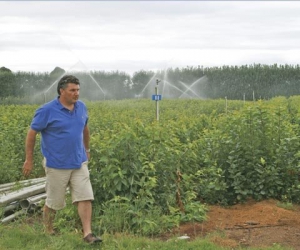
Waimea Nurseries in Nelson, New Zealand, sells about 500,000 nursery trees a year. Managing Director Mike Simpson is pictured with the Cornell-Geneva 210 rootstocks on the left and the taller CG202 on
Traditionally, they’ve used Malling 106 or M.793, partly because they are resistant to woolly apple aphid, and partly because those were the only rootstocks available.
Inspired by the evolution to intensive orchard systems that has taken place in Italy’s South Tyrol and the United States, New Zealand growers are planting at higher densities, using semidwarfing or dwarfing rootstocks. Orchard consultant Craig Hornblow said that in 10 years 60 percent of New Zealand’s tree fruit industry will still have trees on M.106, but the industry is moving and changing.
New Zealand now has only four major tree fruit nurseries, down from a high of 40.
Mike Simpson, managing director at Waimea Nurseries at Nelson, said tree fruit plantings in New Zealand have been on the rise, increasing from a low of about 500,000 to 600,000 trees four years ago to 1 million a year now. Waimea supplies about half those trees, along with a whole range of temperate and subtropical fruit trees and ornamental fruit and shade trees.
Waimea, a member of the International Nursery Network, also grows the rootstocks for its fruit trees. Simpson said the New Zealand industry has made a major switch from Malling 106 and M.793 to M.9, which now accounts for 90 percent of its rootstock production. However, he also notes some interest in the new Cornell-Geneva rootstocks. His nursery is growing CG.202 and CG.210 and expects to increase production of the Cornell-Geneva rootstocks.
Dr. Terence Robinson, horticulturist at Cornell University, New York, said CG.202, which has been available in New Zealand for the past three years, is similar in size to Malling 26. It is resistant to fireblight, woolly apple aphid, and crown rot, and has partial tolerance to replant disease. It is more vigorous and more yield efficient than M.26 on a replant site.
CG.210 is a semidwarf rootstock with high yield efficiency. It is a little more vigorous than M.26. It is resistant to fireblight and woolly apple aphid and very tolerant of replant disease.
“People in New Zealand are very interested in it and we will move ahead as fast as we can,” he reported at the annual convention of the International Fruit Tree Association.
Difficult
Andy McGrath of McGrath Nursery in Cambridge, New Zealand, predicted that CG.202 will be a force in the rootstock business in the future. Nurseries are bulking up both CG.202 and CG.210, though they are expensive and difficult to produce because they don’t root well in the stoolbeds.
Trees on CG.202 transplant well into the orchard, but the graft union is weak with some varieties, so tree support is important.
Nurseries report low productivity with CG.210 in the stoolbed. McGrath said roots are easily damaged during handling, and storage and transplant losses are high. Trees might be expensive because of the poor nursery performance.

Leave A Comment